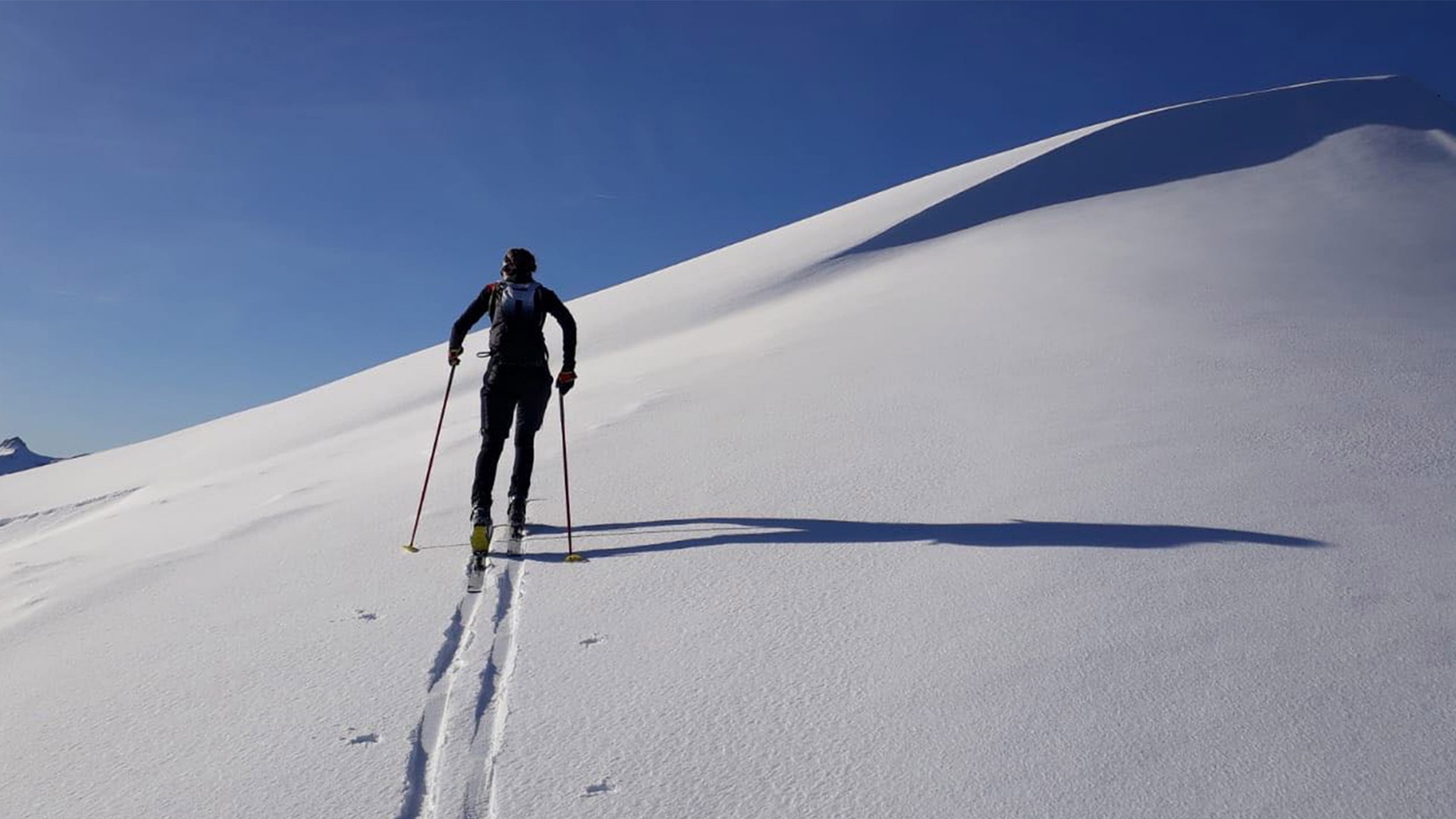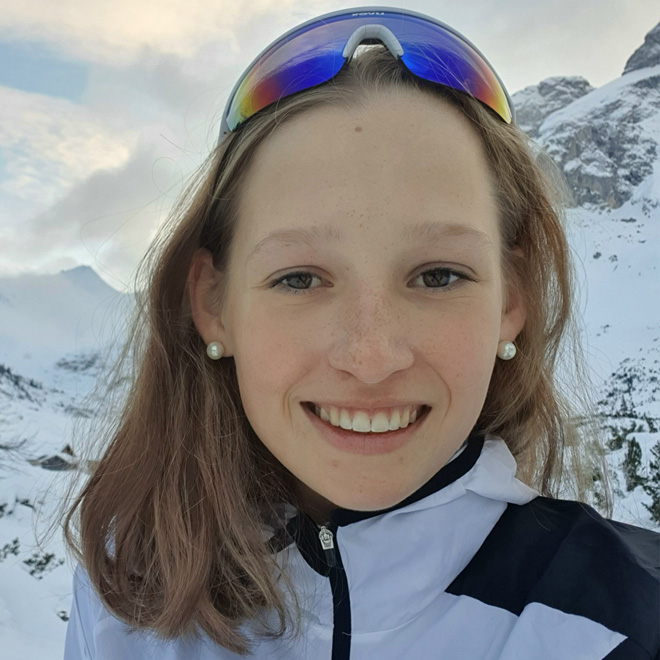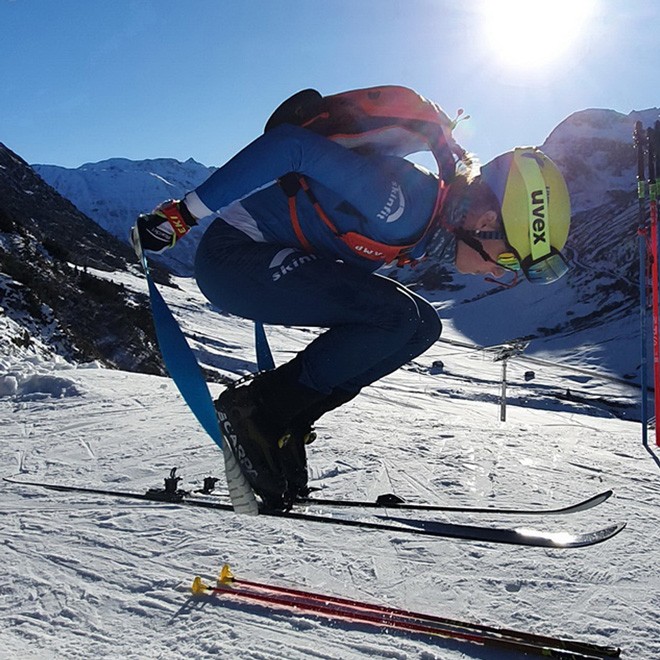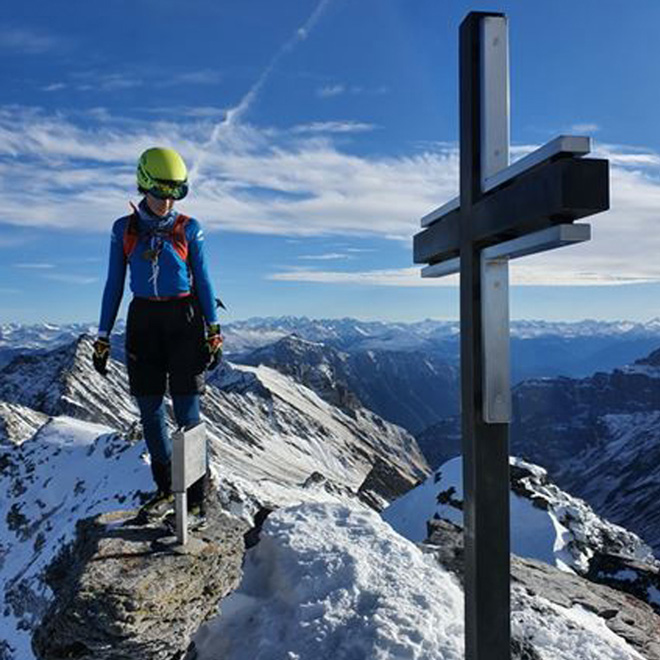until
SKIMO Racing
Ski touring is booming! More and more friends of endurance and winter sports give their heart to the mountains, the untouched snow, the tranquility of nature away from après ski and mass tourism. What hiking is in summer, ski touring takes over in winter. The combination of challenging climbs to the summit experience and the subsequent casual descent through untracked powder snow is now undoubtedly one of the most popular "must do`s" in the snowy winter world.

WELTCUP SKIMO ATHLETING SOPHIA WESSLING IM INTERVIEW
In addition to this recreational boom, there is also a small but select group of ambitious ski mountaineers in the ski or alpine federations who are fighting for recognition of their performance category and for inclusion in the Olympic program - we are talking about skimountaineering (SKIMO).

We met the Skinfit athlete and World Cup SKIMO starter Sophia Weßling from Germany and get up close and personal with her!
Sophia, you have just returned successfully from your World Cup competitions in Switzerland and Italy. What exactly is behind the competitive sport of skimountaineering? And where is the big difference to the current ski touring boom in the tourism industry?
As you say, ski mountaineering is a competitive sport and my motivation to participate in a Skimo race is of course quite different from that which drives my friends and acquaintances on their weekend ski tours. The goal is not to climb a certain peak with a beautiful view, but to run through a course marked out with little flags as quickly as possible, giving your best in direct competition. Especially in the ascent, not only absolute fitness counts, but also every gram. So our equipment differs enormously from that of a ski tourer. My pair of ski touring skis weighs just 1,430g, a single carbon boot only about 600g. All other equipment, such as bindings, helmets and poles, weigh only a fraction of "normal" ski touring equipment. With this lightweight "race" equipment, it is also not a real "downhill pleasure" in powder snow but rather resembles ski artistry on icy mogul slopes. However, our safety equipment remains the same. We need this at least when participating in an individual - one of four disciplines in ski mountaineering. This includes a rescue blanket, whistle, shovel, probe and beep.
So does a SKIMO competition resemble a fast ski tour or are there different race formats?
The competitions take place in four different disciplines and each athlete has their own strengths and weaknesses and therefore preferences as to which race formats suit them best. An Individual Race usually takes place in open terrain off-piste (hence the avalanche safety equipment here). I start in 2022 in the U20 age group. There I have to overcome about 950 vertical meters of ascent (with carrying passages - i.e. the skis are attached to the backpack) as well as descents. The 950 meters of altitude are usually divided into three to four individual ascents. A second discipline in ski mountaineering is sprinting. In my age group, there are only about 65 vertical meters to overcome in a marked out run with exactly one carrying passage and descent. The first run is the qualification. After that, the 24 best runners move on to the quarter finals. In each of the four starting blocks, six athletes will run against each other, and the first three of them will move on to the semifinals with two starting blocks. The best three from each of the two semifinals will reach the final. Here the top 6 will be eliminated. The simplest discipline is the Vertical. As the name already says, it only goes uphill, without a downhill. In my age group I have to run about 400 to 500 meters of altitude at a stretch without a carrying passage. The Vertical usually takes place on the slope. In addition, there is the relay as the fourth discipline. Here each runner completes a very shortened individual course and then hands over to the next starter. A relay can consist of two to four participants. In addition to these various race formats, the competition also includes individual elements such as fast uphill and downhill skiing and climbing without skis. Last year it was announced that ski mountaineering will be part of the Winter Olympics for the first time in a long time: 2026 in Milan. The Vertical did not make it into the program, as it did for the 2020 Youth Olympic Games in Lausanne. Of course, this is a milestone and a great development for my sport.
INDIVIDUAL RACE
Several ascents, carrying passages
& descents in open terrain.
SPRINT RACE
Staked run, which leads in the KO system
with 6 athletes at a time leading to the final.
VERTICAL RACE
Continuous ascent without
carrying passages or descent.
STAFFEL
2 to 4 participants master each
a shortened individual route.
You are already very successful internationally at the age of 19. What are the special challenges of these World Cup races for you?
Luckily I am part of the German national team and go to most of the big races with my team and our coaches. I have to do most of the preparations for the races myself, but I always have good advice with me. One day before the actual race, the right skin as well as the right wax for the ski is already chosen and applied. These decisions are made depending on the gradient of the race course, snow composition, weather, time of day or the associated temperature and can be decisive for the next day's race. A constantly slipping skin or a not well waxed ski, costs energy and speed, so that in the end the decisive seconds can be missing. Especially in an individual, which extends over a large area in the terrain, a course inspection can bring great advantages, especially in the descents and also reduces the risk of falling, because I can already recognize the day before danger spots and examine. Today, however, most organizers have to deal with a lack of snow more and more often and as a result the routes planned at the beginning have to be changed or even completely relocated. Sometimes no route is marked out and known at the presentation, so that I have to make up an approximate route according to a map and memorize it the evening before. In order to avoid a serious fall in the race or to get off the route, I sometimes have to slow down a bit in the downhill part of the race. Sometimes I and other athletes have to stop occasionally in order to regain the right orientation. These "jumps into the deep end" are a new challenge at every World Cup. Likewise, falls at SKIMO races are not an isolated incident. Thanks to the lightweight material and sometimes somewhat softer snow in the terrain, serious injuries are almost always avoided. However, the extremely light material already suffers from short falls. Therefore, broken poles or a broken ski are also often decisive for victory or defeat. Fortunately, there is a checkpoint in the race where our coaches hand out replacement material. However, precious time is lost due to material damage and is difficult to get out again. Arriving at the finish line, the achieved rank is not yet secured. From time to time there are also time penalties for not following the rules, such as a fur part is still outside the race suit to see and thus was not completely stowed or that the marked transition areas were exceeded when mounting or dismounting, etc..
And what is the attraction of the World Cup or ski mountaineering as a competitive sport for you?
What the appeal of ski touring is, is probably very obvious to everyone: untouched nature, a magnificent mountain panorama and fantastic deep snow descents. However, to experience all this as a competitive sport and to reach and overcome your own limits has a completely different motivation for me. To run through a technical course with steep and demanding descents and carrying passages and still bring your maximum performance, requires more than pure endurance and leaves a race open until the end. I love the competition and the physical challenge in the middle of my favorite element - the snow.
As a competitive athlete, you are on skis almost every day in training. Do you also go ski touring in your free time?
Apart from the fact that there is of course nothing more beautiful than being the first to powder down a still untouched slope, for us ski mountaineers the "normal" ski tours are actually of very great importance. On the slopes you can train your endurance perfectly, but you won't learn how to ski down a demanding slope as fast as possible or how to master challenging carrying passages. These elements of ski mountaineering can only be trained by actually doing them. It should also not be underestimated that supposedly easy mountains from the daily trining program can degenerate into a half-day or full-day tour simply due to the snow conditions on other days. Also in the race you have to cope with such difficult conditions as bad weather and low visibility. After the season, I usually go on spring ski tours: long, extended and leisurely tours where the main goal can be pure enjoyment.
You mentioned your protective equipment earlier. What about your avalanche skills? Are theory and practice around safety also part of your training?
Especially in the discipline Individual it is mandatory not only to carry the avalanche transceiver equipment but also to be able to use it. In the German national team there is a course for all at the beginning of the season. However, this course is rarely repeated. So it is not part of the training. Most of the time, World Cup athletes from the national team train alone, so safety is an enormously important topic. Personally, I learned the most about avalanche awareness from my dad and brother during the tours we did together, which gave me the confidence to do my first ski tour alone in the backcountry at the age of 17. It is still important to me today to be as safe as possible on the road. Unfortunately, the ongoing ski touring boom also brings more and more untrained people into the terrain. Here, as a competitive athlete, I naturally also want to live up to my role as a role model and take the responsibility very seriously.
In addition to the World Cup, which is organized by the international SKIMO federation, there are also numerous traditional races that offer a stage for professionals as well as many amateur athletes. Do you also have plans outside the national team?
Yes definitely! Especially the PDG (Patrouille des Glaciers), Sellaronda, Tropheo Mezzalama and Pierramenta have done it to me and belong to the "must-do" program for ambitious ski mountaineers. Except for the Sellaronda, where I will already be at the start this year with my friend Maria Hüber, all three races are over 3000 meters in altitude and are done together with a partner. They therefore belong to the long distance races. The Pierramenta is even a multi-day race. I think every Skimo athlete dreams of being at the front of the pack in these historic races, and I still have a few years to go.
You are currently competing in the U20 class. The next step is then the women's elite. Is being a professional your goal? Is it possible to live from the sport of skimountaineering nowadays?
No, unfortunately I can't make a living from sport. The prize money alone for achieving a top 5 place in the World Cup is not enough. Like most other ski mountaineers in my immediate environment, I would also like to start studying after graduating from high school and continue to pursue competitive sports in parallel. To concentrate completely on the sport, as for example through top sport promotion in the police or the Bundeswehr, is out of the question for me. Ski mountaineering is (currently) simply too small for that and hardly gets any media interest.
MÖCHTEST DU MEHR ÜBER SOPHIA ERFAHREN?


